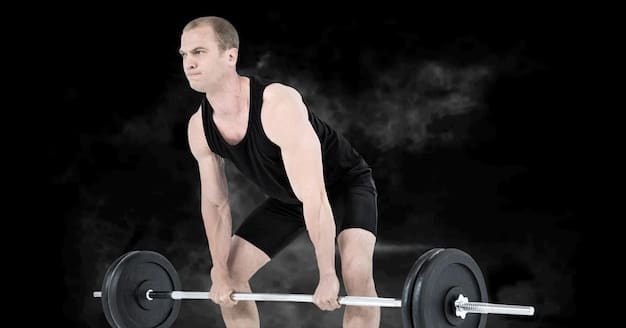Maximize Muscle Growth: 5-Day Split Routine for 2025

To maximize muscle growth: the updated 5-day split routine for 2025 offers a structured, efficient, and science-backed approach, optimizing training frequency and volume across different muscle groups for superior hypertrophy and strength gains.
In the evolving landscape of fitness, optimizing your workout routine is paramount for continuous progress. This article delves into how to maximize muscle growth: the updated 5-day split routine for 2025, offering insights grounded in the latest scientific understandings of hypertrophy and recovery. We’ll explore why this specific split remains a cornerstone for advanced trainees and how it can be tailored to meet your individual goals.
Understanding the Core Principles of Muscle Growth
Before diving into the specifics of the 5-day split, it’s crucial to grasp the fundamental mechanisms driving muscle growth, or hypertrophy. This understanding forms the bedrock upon which any effective training program is built, ensuring that every rep and every set contributes meaningfully to your gains.
Mechanical Tension: The Primary Stimulus
Mechanical tension is widely considered the most critical factor for muscle hypertrophy. This refers to the force applied to the muscle fibers during an exercise. To maximize this, you need to lift challenging weights through a full range of motion. The tension signals the muscle to adapt by growing stronger and larger.
- Progressive Overload: Continually increasing the demands on your muscles.
- Full Range of Motion: Maximizing the time under tension for each muscle fiber.
- Controlled Movements: Avoiding momentum to keep tension on the target muscle.
Muscle Damage: Triggering Repair and Growth
When you lift weights, especially new or challenging movements, microscopic damage occurs to muscle fibers. This damage isn’t inherently bad; it’s a signal for the body to initiate repair processes, and in doing so, it rebuilds the damaged fibers stronger and larger than before. Delayed onset muscle soreness (DOMS) is a common indicator of this process, though its absence doesn’t mean growth isn’t occurring.
While muscle damage is a component of hypertrophy, excessive damage can impede recovery and overall progress. The goal is to induce sufficient damage to stimulate adaptation without leading to overtraining.
Metabolic Stress: The “Pump” Effect
Metabolic stress, often associated with the “pump” sensation, involves the accumulation of metabolites like lactate, hydrogen ions, and inorganic phosphate within the muscle. This accumulation contributes to cell swelling, which has been shown to be an independent mechanism for muscle growth. It signals an anabolic response, promoting protein synthesis and satellite cell activation.
Incorporating techniques that enhance metabolic stress, such as higher rep ranges, shorter rest periods, and isolation exercises, can be a valuable addition to compound lifts focused on mechanical tension.
Deconstructing the 5-Day Split: Why It Works
The 5-day split routine has been a staple in bodybuilding for decades, and for good reason. It allows for a high training frequency for each major muscle group within a week while providing adequate recovery time. This balance is key for optimizing both stimulus and recuperation, two critical components for sustained muscle growth.
Optimized Frequency and Recovery
A typical 5-day split often involves training each major muscle group once or twice a week. While some research suggests that higher frequencies (2-3 times per week per muscle group) can be superior for beginners, for intermediate to advanced lifters, a 5-day split strikes an excellent balance. It allows for sufficient recovery (48-72 hours) for a muscle group before being trained again, ensuring peak performance during each session and minimizing the risk of overtraining.
This systematic approach also allows for specific focus on individual muscle groups, dedicating an entire session or half-session to stimulating a particular area with multiple exercises and angles. This targeted approach is crucial for bringing up lagging body parts and achieving symmetrical development.
High Volume, Targeted Training
With a 5-day split, you can dedicate more exercises and sets to each muscle group per session compared to full-body or upper/lower splits. This higher volume per muscle group is essential for advanced trainees who require more stimulus to continue growing. For example, a dedicated back day can include various pulling movements—rows, pull-downs, deadlifts—to hit the back from multiple angles.
The structure also facilitates a mind-muscle connection. When you’re focusing on only one or two muscle groups, you can channel your attention entirely to feeling those muscles work, enhancing activation and overall effectiveness of the exercises. This focused attention is a powerful tool for maximizing hypertrophy.

The Updated 5-Day Split Routine for 2025: A Modern Approach
While the fundamental structure of a 5-day split remains consistent, the 2025 updated version incorporates modern insights into exercise selection, progression strategies, and recovery modalities. This isn’t just about showing up; it’s about smart, intentional training that maximizes every aspect of your effort.
Considerations for Exercise Selection and Progression
The core of any effective routine lies in its exercise selection. Prioritize compound movements that engage multiple muscle groups, as these provide the most bang for your buck in terms of mechanical tension and overall systemic stimulus. Examples include squats, deadlifts, bench presses, overhead presses, and various rows. These should form the backbone of your routine, typically performed at the beginning of each workout when you’re freshest and strongest.
Following compound movements, incorporate isolation exercises to target specific muscles and enhance metabolic stress or improve symmetry. For progression, the principle of progressive overload is king. This can manifest in various ways beyond simply adding more weight:
- Increasing reps with the same weight.
- Performing more sets.
- Decreasing rest times between sets.
- Improving exercise form and range of motion.
- Increasing training frequency per muscle group (where appropriate).
The key is consistency in applying these progression methods over time. Regular tracking of your workouts is essential to monitor progress and adjust your routine as needed.
Sample 5-Day Split Routine (2025 Edition)
This sample routine prioritizes strategic division of muscle groups to allow for optimal recovery and targeted training. Remember to warm up thoroughly before each session and cool down with stretching afterwards.
Day 1: Chest & Triceps
This day focuses on pushing movements, targeting the chest and the synergistic triceps muscles. Prioritize compound chest exercises before moving to triceps.
- Barbell Bench Press: 3-4 sets of 6-10 reps
- Incline Dumbbell Press: 3 sets of 8-12 reps
- Cable Crossover (low to high): 3 sets of 10-15 reps
- Overhead Dumbbell Extension: 3 sets of 8-12 reps
- Triceps Rope Pushdown: 3 sets of 10-15 reps
Day 2: Back & Biceps
A dedicated day for pulling movements, engaging the large muscles of the back and the contributing biceps. Focus on form to ensure maximum back activation.
- Pull-ups (or Lat Pulldown): 3-4 sets to failure (or 8-12 reps)
- Barbell Rows: 3 sets of 8-12 reps
- Seated Cable Rows: 3 sets of 10-15 reps
- Face Pulls: 3 sets of 15-20 reps
- Barbell Curls: 3 sets of 8-12 reps
- Hammer Curls: 3 sets of 10-15 reps
Day 3: Legs & Abs
Leg day is crucial for overall muscle growth and hormonal response. Incorporate a mix of squat, hinge, and isolation movements, plus core work.
- Barbell Squats: 3-4 sets of 6-10 reps
- Romanian Deadlifts: 3 sets of 8-12 reps
- Leg Press: 3 sets of 10-15 reps
- Leg Extensions: 3 sets of 12-15 reps
- Hamstring Curls: 3 sets of 12-15 reps
- Standing Calf Raises: 4 sets of 15-20 reps
- Cable Crunches: 3 sets of 15-20 reps
- Leg Raises: 3 sets of 15-20 reps
Day 4: Shoulders & Traps
Targeting the deltoids from all angles for comprehensive shoulder development, alongside the trapezius.
- Overhead Press (Barbell or Dumbbell): 3-4 sets of 6-10 reps
- Lateral Raises: 3 sets of 12-15 reps
- Front Raises: 3 sets of 10-15 reps
- Reverse Pec Deck Flyes: 3 sets of 12-15 reps
- Barbell Shrugs: 4 sets of 8-12 reps
Day 5: Full Body/Weak Point Focus (Optional but Recommended)
This day can be used to hit a muscle group that needs more attention, or to perform a lighter full-body session. It allows for additional frequency without overtraining a specific area. If you have a lagging muscle group, dedicate this day to a few sets for that area.
- Example (if Weak Point is Back): Light Deadlifts, Pull-downs, Cable Rows.
- Example (Full Body): 1-2 sets of a compound movement for Chest, Back, Legs, Shoulders.
Day 6 & 7: Rest Days
Crucial for recovery, muscle repair, and growth. Incorporate active recovery like light walks or stretching if desired.
This example highlights a structured approach. Remember to adjust sets, reps, and exercises based on your personal response, recovery capabilities, and specific goals. The “updated” aspect comes from the personalized application and continuous refinement based on individual progress.
Nutrition and Recovery: The Unsung Heroes of Muscle Growth
Training is only one piece of the puzzle when it comes to maximizing muscle growth. Without proper nutrition and adequate recovery, even the most perfectly structured 5-day split will yield suboptimal results. These two elements are non-negotiable for anyone serious about building muscle.
Fueling Muscle Synthesis: Macro and Micronutrients
Your diet needs to support your intense training regimen and provide the building blocks for new muscle tissue. This means paying close attention to your macronutrient intake (protein, carbohydrates, fats) and ensuring you get a wide array of micronutrients (vitamins and minerals).
- Protein: The cornerstone of muscle repair and growth. Aim for 1.6-2.2 grams of protein per kilogram of body weight spread throughout the day. Prioritize lean sources like chicken, beef, fish, eggs, dairy, and plant-based options like legumes and tofu.
- Carbohydrates: Your primary energy source for intense workouts and crucial for replenishing glycogen stores in muscles. Consume complex carbs like whole grains, fruits, and vegetables. Intake should be adjusted based on activity level but typically ranges from 4-6 grams per kilogram of body weight.
- Fats: Essential for hormone production, nutrient absorption, and overall cellular function. Include healthy fats from avocados, nuts, seeds, olive oil, and fatty fish. Aim for 0.8-1 gram per kilogram of body weight.
- Hydration: Often overlooked, but critical for performance, nutrient transport, and metabolic processes. Drink plenty of water throughout the day, especially around your workouts.
Eating in a slight caloric surplus is generally necessary for muscle growth, as gaining muscle is an energy-intensive process. Tracking your intake for a period can help you understand your current habits and make necessary adjustments.
The Power of Sleep and Active Recovery
Muscle growth doesn’t happen in the gym; it happens during recovery, particularly during sleep. During deep sleep, your body releases growth hormone, which is vital for tissue repair and growth. Aim for 7-9 hours of quality sleep per night. Poor sleep can impair recovery, reduce strength, and negatively affect hormone levels.
Active recovery, such as light walks, stretching, foam rolling, or gentle yoga, can also play a role in optimizing recovery. These activities can improve blood flow, reduce muscle soreness, and enhance flexibility without placing additional stress on your system. They help clear metabolic byproducts and prepare your body for the next intense training session.
Addressing Common Challenges and Optimizing for 2025
Even with a well-designed 5-day split, individuals may encounter challenges that impede progress. The 2025 approach emphasizes adaptability and data-driven adjustments to overcome plateaus and ensure continuous gains, integrating newer understanding of training methodologies and individual variations.
Overcoming Training Plateaus
Plateaus are inevitable in any long-term training journey. When you stop seeing progress in strength or size, it’s a signal to change something. Simply doing more of the same, or just increasing the weight by tiny increments, often isn’t enough. Here’s how to address them:
- Deload Weeks: Periodically reduce your training volume and/or intensity (e.g., every 6-8 weeks) for a week. This allows your body to fully recover and resensitize to the training stimulus, often leading to renewed progress afterwards.
- Vary Rep Ranges: Don’t stick to just 8-12 reps. Incorporate heavier sets of 4-6 reps for strength gains and lighter sets of 15-20 reps for metabolic stress and endurance.
- Exercise Variation: Swap out exercises for similar ones. For instance, if you’ve been doing barbell bench press, try dumbbell press or machine press for a few weeks. This changes the stimulus slightly and can re-engage muscles.
- Advanced Techniques: Consider incorporating techniques like drop sets, supersets, rest-pause sets, or forced reps (with a spotter) occasionally to push past limits. Use these sparingly as they are highly demanding.
Periodization and Individualization
For 2025, the emphasis is increasingly on periodization, which involves cycling training phases with different focuses (e.g., hypertrophy, strength, power). While a strict periodized plan might be for competitive athletes, understanding the concept allows for flexible application. You might spend 8-12 weeks focusing primarily on hypertrophy principles, then 4-6 weeks with a greater emphasis on strength, before returning to hypertrophy. This cyclical variation helps prevent plateaus and keeps training fresh.
Individualization means recognizing that what works for one person may not work perfectly for another. Genetic predispositions, lifestyle factors, stress levels, and recovery capacities all dictate how you respond to training. Therefore, constantly evaluating your own progress, energy levels, sleep quality, and muscle soreness is vital. Be prepared to adjust your routine, exercise selection, volume, or rest days based on how your body feels and responds.

Integrating Mind-Muscle Connection and Form
Beyond simply moving weight from point A to point B, the quality of your repetitions and the intentional focus on the working muscle are critical for maximizing hypertrophy. The mind-muscle connection and impeccable form are not optional; they are foundational pillars of effective training.
The Power of Intentional Contraction
The mind-muscle connection refers to your ability to consciously contract the target muscle throughout the exercise. Instead of just “lifting the weight,” you should actively focus on feeling the muscle stretch under resistance and then contract maximally. This enhances muscle fiber activation and ensures the intended muscle is bearing the majority of the load, rather than relying on secondary muscles or momentum.
To improve your mind-muscle connection:
- Slower Reps: Reduce the speed of your repetitions, especially the eccentric (lowering) phase. This increases time under tension and allows more time for the brain to send signals to the muscle.
- Light Weight Practice: Start with lighter weights to perfect your form and really feel the muscle working before increasing the load.
- Tactile Cues: Sometimes touching the muscle with your free hand can help you feel it engage.
- Visualize: Imagine the muscle fibers contracting and stretching with each rep.
This intentional focus can often be more impactful than simply adding more weight, especially for isolation exercises.
Prioritizing Flawless Form Over Heavy Weight
Proper exercise form is non-negotiable for two primary reasons: maximizing muscle activation and preventing injuries. Lifting with poor form often means the target muscle isn’t being effectively stimulated. Instead, other muscles compensate, or momentum takes over, leading to less effective training and an increased risk of strains, sprains, or more serious injuries.
Always choose a weight that allows you to maintain strict form throughout the entire range of motion. If your form breaks down, reduce the weight slightly until you can execute the movement perfectly. Regularly review videos of your lifts or seek feedback from experienced trainers to ensure your technique is sound.
Remember, the goal is to safely and effectively stimulate muscle growth, not just to lift the heaviest weight possible. Quality of repetitions will always trump quantity or ego lifting.
Advanced Strategies and Future Trends for 2025
As we look towards 2025 and beyond, the fitness landscape will continue to evolve, with increasing emphasis on data-driven approaches, personalized programming, and leveraging technology to optimize results. Integrating these advanced strategies into your 5-day split can provide an edge for those seeking to maximize their potential.
Leveraging Wearable Technology and Data Analytics
Wearable devices have moved beyond simple step counting. Modern smartwatches and fitness trackers can monitor heart rate variability (HRV), sleep quality, recovery metrics, and even suggest optimal training loads based on your physiological state. HRV, in particular, is gaining traction as a reliable indicator of recovery. A higher HRV generally suggests better recovery and readiness for intense training, while a lower HRV might indicate accumulated fatigue or stress, signaling a need for more rest or a deload.
Analyzing this data can help you make informed decisions about your training frequency, intensity, and when to incorporate active recovery or rest days. Integrating apps that log your workouts and provide analytics on volume, intensity, and progression over time also becomes crucial for identifying trends and making data-backed adjustments to your 5-day split.
Personalized Nutrition and Supplementation
While general guidelines for nutrition are helpful, 2025 will see an increased trend towards personalized nutrition plans based on individual metabolic responses, genetic predispositions, and activity levels. Blood tests can offer insights into nutrient deficiencies or hormonal imbalances impacting recovery and growth. This isn’t about rigid diets but optimizing nutrient timing and macro ratios for your unique body.
Supplementation, too, is becoming more targeted. Beyond foundational supplements like protein powder and creatine, advanced athletes might explore targeted pre-workouts, specific amino acid profiles, or recovery aids backed by emerging science. However, it’s vital to remember that supplements complement, not replace, a solid diet and training plan. Always consult with a healthcare professional or a registered dietitian before introducing new supplements.
Looking ahead, the commitment to the 5-day split, combined with smart progression, meticulous nutrition, dedicated recovery, and the intelligent application of evolving fitness technology, promises a clear path to significant and sustainable muscle growth.
Conclusion: The Path to Consistent Muscle Growth
The updated 5-day split routine for 2025 is more than just a training schedule; it’s a comprehensive framework designed to maximize your potential for muscle growth. By meticulously balancing training stimulus, providing ample recovery, and integrating principles of progressive overload, optimal nutrition, and mindful execution, this routine offers a powerful roadmap for consistent and significant gains. Remember, consistency, adaptability, and unwavering dedication to the process are your greatest allies on this journey.
| Key Aspect | Brief Description |
|---|---|
| 🏋️ Split Focus | Dedicated days for muscle groups provide targeted, high-volume stimulus. |
| 🔄 Progressive Overload | Continuous increase in demands is essential for adaptation and growth. |
| 🍎 Nutrition & Recovery | Crucial for muscle repair, energy, and overall growth; includes sleep and diet. |
| 🧠 Mind-Muscle Connection | Conscious contraction enhances muscle activation and training effectiveness. |
Frequently Asked Questions About the 5-Day Split
▼
While beginners can certainly benefit, it’s often recommended they start with a full-body or upper/lower split to build foundational strength and learn proper form before transitioning to a higher-frequency, higher-volume 5-day split. It allows for more specific muscle focus.
▼
Workout duration should ideally be between 60 to 90 minutes, including warm-up and cool-down. Going much longer can lead to diminishing returns, increased cortisol levels, and fatigue, potentially hindering recovery and growth.
▼
Absolutely. The sample 5-day split is a template. You can swap days around to fit your schedule and recovery needs, as long as you ensure adequate rest for each muscle group before it’s trained again. Consistency is more important than rigid adherence to a specific day.
▼
Life happens. If you miss a day, simply pick up where you left off. Don’t try to double up or cram in two days’ worth of training. You can adjust your next week’s schedule or just accept the missed session and move forward.
▼
It’s beneficial to make minor adjustments every 4-8 weeks to prevent plateaus and keep your muscles adapting. This could involve changing specific exercises, rep ranges, set schemes, or integrating new techniques. A complete overhaul might be needed every 3-6 months.
Final Thoughts on Building Your Physique
Embarking on the journey to maximize muscle growth with the updated 5-day split routine for 2025 is a commitment to not just physical transformation, but also to understanding your body’s intricate responses to training. It demands consistency, patience, and a willingness to adapt your strategies based on real-time feedback from your progress and recovery. By embracing the principles of progressive overload, prioritizing high-quality nutrition and sufficient rest, and refining your technique with every repetition, you lay a solid foundation for sustainable gains. This isn’t just about following a plan; it’s about building a lifestyle that supports your ultimate fitness aspirations, ensuring that every effort in the gym translates into tangible, impressive results.





